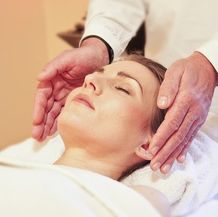 By Phila Hoopes The word Reiki combines two Japanese words - Rei, meaning "God's Wisdom or the Higher Power" and Ki, meaning "life force energy". So you can define Reiki as "spiritually guided life force energy." Reiki is a Japanese healing technique by which this energy is transmitted through the laying on of hands to support relaxation and relief from stress, pain, and illness in the mind, body or spirit, and promote healing. So, you may say, we’re looking at some serious “woo” here, right? Actually – while practitioners may take a wide range of approaches, some more “woo-woo” than others, traditional Usui Reiki is gaining genuine recognition in the world of conventional medicine. While mainstream science hasn’t yet identified how it works, the National Center for Complementary & Alternative Medicine (NCCAM) of the National Institutes of Health (NIH) classifies Reiki as a form of biofield therapy. Researcher Pamela Miles teaches that Reiki affects the vibrational body, gently supporting its natural self-healing mechanisms by fostering balance.* In the 95 years since Mikao Usui established the practice of Reiki, practitioners have found that it may be used effectively for anyone, human or nonhuman, in person or remotely. It supports all other medical or alternative approaches to relieve symptoms and side effects and promote recovery. Because it involves no physical manipulation, nor the ingestion or application of any drugs, creams, or oils, it has no known contraindications. It’s impossible to be allergic to Reiki! For all of these reasons, Reiki is used as a supplement to conventional and integrative care in 76 hospitals in the U.S. and abroad, treating a wide range of conditions including:
So, you may ask – what does Reiki feel like? Well, you remain clothed, and you may be sitting or lying down. The practitioner may gently place hands on your body – or may hold hands a few inches above your body – in a series of locations roughly corresponding to the chakras. You may feel warmth, heat, or tingling in those areas, and most people report feeling a sense of relaxation that deepens as the session progresses. A session may be as short as 15 minutes or as long as 90. Afterward, you may feel sleepy – or energized! It’s common to experience shifts, whether physical, psychological or emotional: if you have been blocked in some way (whether it’s, say, constipation, a charley-horse, or blocked emotions), you may experience a release. To integrate your Reiki experience and energy release, be gentle to yourself! Drink plenty of water, get plenty of sleep (and pay attention to your dreams!). Observe your experience with love and acceptance, remembering that this is energy moving. If you experience a major psychological or emotional release, stay in contact with your therapist to process the thoughts and feelings. And if you have any questions, please contact me at phila@allrelationsreiki.com. I look forward to seeing you! _____________________________________________ * Pamela Miles, Reiki: A Comprehensive Guide (New York: Penguin, 2008), 8
0 Comments
Leave a Reply. |
Proudly powered by Weebly


 RSS Feed
RSS Feed